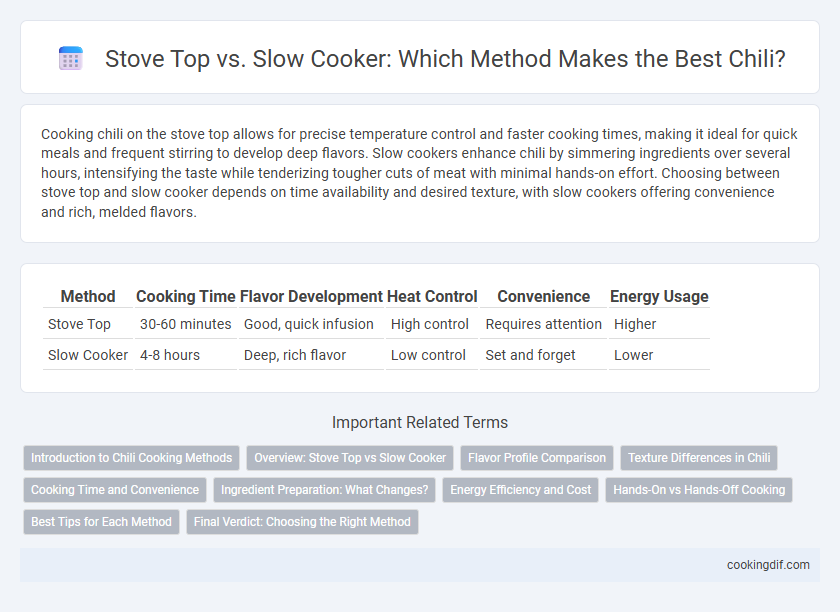Cooking chili on the stove top allows for precise temperature control and faster cooking times, making it ideal for quick meals and frequent stirring to develop deep flavors. Slow cookers enhance chili by simmering ingredients over several hours, intensifying the taste while tenderizing tougher cuts of meat with minimal hands-on effort. Choosing between stove top and slow cooker depends on time availability and desired texture, with slow cookers offering convenience and rich, melded flavors.
Table of Comparison
| Method | Cooking Time | Flavor Development | Heat Control | Convenience | Energy Usage |
|---|---|---|---|---|---|
| Stove Top | 30-60 minutes | Good, quick infusion | High control | Requires attention | Higher |
| Slow Cooker | 4-8 hours | Deep, rich flavor | Low control | Set and forget | Lower |
Introduction to Chili Cooking Methods
Stove top cooking of chili allows precise temperature control and faster ingredient melding, ideal for thickening and layering flavors in under an hour. Slow cookers offer low, consistent heat that tenderizes tougher meats and deepens chili's complexity over several hours, perfect for hands-off preparation. Choosing between methods depends on desired texture, time availability, and flavor development preferences in chili recipes.
Overview: Stove Top vs Slow Cooker
Stove top cooking offers rapid heat control and is ideal for quickly simmering chili to develop robust flavors, while slow cookers use low, consistent temperatures for several hours to tenderize ingredients and deepen spiciness. The stove top allows for frequent stirring and adjustment of seasoning during cooking, enhancing texture and taste customization. Slow cookers provide convenience with set-it-and-forget-it operation, perfect for busy schedules and making chili with minimal active time.
Flavor Profile Comparison
Stove top chili develops a robust and deep flavor through direct high-heat cooking, which enhances Maillard reactions and creates a rich, slightly caramelized taste. Slow cooker chili allows spices and ingredients to meld slowly over hours, producing a well-rounded, tender, and complex flavor profile with subtle subtleties and a smoother texture. Each method uniquely influences the chili's flavor intensity, with stove top delivering boldness and slow cooker providing harmonious depth.
Texture Differences in Chili
Stove top cooking produces chili with a firmer texture, allowing beans and meat to retain distinct shapes and a slightly chewy bite. Slow cookers break down ingredients more thoroughly, resulting in a smoother, more homogenous chili with tender meat and soft beans. The choice between stove top and slow cooker significantly impacts chili's texture, influencing mouthfeel and flavor absorption.
Cooking Time and Convenience
Stove top chili typically cooks in 1 to 2 hours, allowing for quicker meal preparation and easy temperature adjustments to control flavor and texture. Slow cookers require 6 to 8 hours on low heat, offering hands-off convenience ideal for busy schedules, while melding spices and ingredients for richer taste. Choosing between methods depends on balancing immediate cooking needs with the benefit of enhanced depth of flavor from extended slow cooking.
Ingredient Preparation: What Changes?
When preparing chili ingredients, stove top cooking requires browning meat and sauteing aromatics separately to build flavor, while slow cooker meals often start with raw ingredients added directly, allowing flavors to meld over time. Chopping vegetables uniformly is more crucial for slow cookers to ensure even cooking during long simmering periods. Spices for stove top chili can be adjusted mid-cooking for immediate taste tests, whereas slow cooker recipes demand precise seasoning upfront since flavors intensify gradually.
Energy Efficiency and Cost
Using a stove top to cook chili typically consumes more energy due to prolonged high heat and frequent stirring, leading to higher utility costs. Slow cookers operate at lower temperatures over extended periods, offering superior energy efficiency by maintaining consistent heat with minimal power use. Investing in a slow cooker can reduce overall cooking expenses while preserving flavor and texture in chili preparation.
Hands-On vs Hands-Off Cooking
Stove top cooking requires constant attention, allowing precise control over heat and seasoning adjustments, which enhances the flavor development through active stirring and monitoring. Slow cookers offer a hands-off experience by maintaining low, consistent temperatures over several hours, ideal for tenderizing meat and melding spices without frequent intervention. Choosing between stove top and slow cooker methods depends on whether you prefer interactive cooking or convenient, unattended meal preparation.
Best Tips for Each Method
For stovetop chili, maintain a consistent simmer over medium-low heat and stir frequently to prevent burning while allowing flavors to meld. Slow cooker chili benefits from low-and-slow cooking, typically 6-8 hours on low, which tenderizes meat and deepens spice infusion without needing much attention. Use fresh aromatics like onions and garlic sauteed beforehand for stovetop pots, and add delicate herbs late in slow cooker recipes to preserve their bright flavors.
Final Verdict: Choosing the Right Method
Cooking chili on a stove top allows for precise temperature control and quicker results, ideal for those seeking a fast, customizable texture and flavor. Slow cookers, however, excel in melding spices and tenderizing meat over hours, producing a richer, more developed taste with minimal hands-on time. Choosing the right method depends on your schedule and flavor preference: stove top for efficiency and slow cooker for depth of flavor.
Stove Top vs Slow Cooker for method Infographic

 cookingdif.com
cookingdif.com